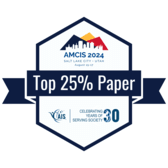Loading...
Paper Type
ERF
Abstract
In recent times, there has been a surge in the popularity and use of generative artificial intelligence (GAI) systems. While GAI systems can potentially make people and organizations more efficient, malicious actors can exploit existing vulnerabilities in these systems. Prompt engineering - the act of interacting with GAI systems via text to produce content - has been used for adversarial purposes. In this study, we examine how linguistic text features and psychological triggers in prompts impact the success of malicious prompts. Our preliminary results show that less concrete prompts have a positive relation with malicious prompt success, and this is also the case for psychological triggers such as trust and urgency. Meanwhile, psychological triggers such as authority and reward show a negative relationship with adversarial prompt success. To contribute to theory and practice, we intend to elaborate on these findings further using a data-driven, computationally intensive theory-building approach.
Paper Number
1589
Recommended Citation
Arhin, Kofi and Jia, Haiyan, "Cracking the Code: Examining Linguistic Elements in Adversarial Prompt Engineering" (2024). AMCIS 2024 Proceedings. 5.
https://aisel.aisnet.org/amcis2024/ai_aa/ai_aa/5
Cracking the Code: Examining Linguistic Elements in Adversarial Prompt Engineering
In recent times, there has been a surge in the popularity and use of generative artificial intelligence (GAI) systems. While GAI systems can potentially make people and organizations more efficient, malicious actors can exploit existing vulnerabilities in these systems. Prompt engineering - the act of interacting with GAI systems via text to produce content - has been used for adversarial purposes. In this study, we examine how linguistic text features and psychological triggers in prompts impact the success of malicious prompts. Our preliminary results show that less concrete prompts have a positive relation with malicious prompt success, and this is also the case for psychological triggers such as trust and urgency. Meanwhile, psychological triggers such as authority and reward show a negative relationship with adversarial prompt success. To contribute to theory and practice, we intend to elaborate on these findings further using a data-driven, computationally intensive theory-building approach.
When commenting on articles, please be friendly, welcoming, respectful and abide by the AIS eLibrary Discussion Thread Code of Conduct posted here.




Comments
SIGAIAA